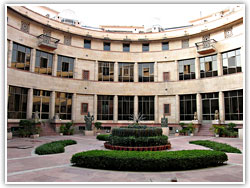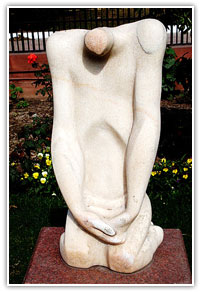|
|
Delhi Museums
.............................................................................................................................................................................. |
|
|
|
National Museum
The National Museum is one of the best museums in
the country, at Janpath in Delhi. It gives an excellent
overview of the cultural development of South
Asia. The collection formed from the nucleus of
the Exhibition of Indian Art, London which brought
together selected works from state museums and
privated collections. Now merged with the Asian
Antiquities Museum it displays a rich collection
of the artistic treasure of Central Asia and
India. The museum provides a comprehensive review
of |
 |
|
|
ethnological objects from prehistoric archaeological
finds to the late Medieval period. Research is
facilitated by a library. Films are screened every day.
Replicas of exhibits on display and books on Indian
culture and art are on sale at the entrance. The items
in the Prehistoric Gallery include seals, figurines, toy
animals and jewellery from the Harappan civilization.
The items in the Maurya Period gallery include
Terracottas and stone heads from the Sunga period, the
chaturmukha lingam, a four faced phallic symbol
connected with the worship of Siva. The items in the
Gandhara School gallery include a series of stucco heads
showing the Graeco Roman influence. Gupta terracottas
include two life size images of the river goddesses
Ganga and Yamuna and the four-armed bust of Vishnu from
temple near Lal Kot, south Indian sculpture from Pallava
and early Chola temples and relief panels from Mysore,
bronzes from the Buddhist monastery. Illustrated
manuscripts includes the Babur-i-nama in the emperor’s
own handwriting and an autographed copy of Jahangir’s
memoirs. Miniature paintings includes the 16th century
Jain School, the 18th century Rajasthani School and the
Pahari Schools of Garhwal, basoli and Kangra. Aurel
Stein Collection consists of antiquities recovered by
him during his explorations of Central Asia and the
western borders of China at the turn of the century,
pre-Columbian and Mayan artifacts. Anthropological
Section is devoted to Indian tribal artifacts and folk
arts. Sharan Rani Bakkiwal Gallery of Musical
instruments displays over 300 instruments collected by
the famous sarod player Sharad Rani and donated to the
museum in 1980.
Airforce Museum
Airforce Museum is situated on the Palam Marg. Guns,
bullets, uniforms and photographs record the history of
the Indian Air Force. There is also an excellent
aircraft.
Crafts Museum
Crafts Museum is located at Pragati Maidan. It contains
over 20,000 pieces of traditional Indian crafts from all
parts of the country. It also contains a rich collection
of 18th-20th century objects including terracottas,
bronzes, enamel work, wood painting and carving,
brocades and jewllery.
Dolls Museum
Dolls Museum is located at Nehru House, Bahadur Shah
Zafar Marg. It looks like something of a miniature
United Nations and started in 1954 by the well known
journalist Shankar. Over 6,000 dolls are displayed here.
The BC Roy Children’s Library offers a wide selection of
books and there is a play corner for those below reading
age. Membership is restricted to under 16s. Films are
screened for members on 2nd Saturday.
Field Museum
Field Museum is located at Purana Qila, Mathura Rd. The
museum displays archaeological finds of excavations at
this site, below which lies the legendary city of
Indraprashta described in the Mahabharata. Coins from
the early Sunga period, red earthenware from the Kushan
period, seals and figurines from the Gupta period and
stone sculptures are displayed. Later artifacts include
coins from the Rajput period, glazed ware and coins from
the Sultanate period.
Gandhi Darshan
Gandhi Darshan is located at Raj Ghat. Five pavilions
bring together in sculpture, photographs and paintings
on the life of Gandhi, the history of the Satyagraha
movement, the philosophy of non-violence and the
Constructive Programme formulated by Gandhi. A
children’s section recreates the history of the freedom
movement from 1857 to 1948 when Gandhi was assassinated.
Gandhi Smarak Sangrahalaya
Gandhi Smarak Sangrahalaya is located at Raj Ghat. It
displays some of Gandhi’s personal belongings like
walking stick, spinning wheel, sandals, watch and
spectacles. There is a small library and collection of
tape recordings of speeches. Films on the Sarvodaya
movement and allied subjects are screened on Sundays.
|
|
|
|
National Gallery of Modern Art
National Gallery of Modern Art is located at
Jaipur House. This gallery is housed in the former
Delhi residence of the Maharaja of Jaipur. There
is an excellent collection of Indian modern art.
Some of the best exhibits are on the ground floor
which is devoted to post 1930 works. Visitors who
would like to view the collections chronologically
are advised to begin their tour on the first
floor. Some of the collections displayed are of
Amrita Shrgil which contains over 100 examples of
her work, including one self portrait. Her style
was a synthesis of the flat treatment of Indian
painting with a realistic tone. There are
collections of Rabindranath Tagore, a poet who for
a brief but intense spell in the 1930s expressed
himself through painting as well as poetry. The
collections of the Bombay School includes the
paintings of Western painters who documented their
visits to India. Formemost among them is the
British painter Thomas Daniell. With a style that
seems |
 |
|
|
to
anticipate the camera, the realism characteristic of
this school is reflected in Indian painting of the early
19th century represented by the schools of Avadh, Patna,
Sikkim and Tanjore. In the Bengal School, artists such
as Abanindranath Tagore and Nandalal Bose have their
works exhibited here. Western influence was discarded in
response to the nationalist movement. Inspiration
derived from Indian folk art is evident in the works of
Jamini Roy, and in the works of Y.D. Shukla. The
Japanese influence can be seen in the use of wash
techniques and a miniature style. Some of the works
would benefit from better labeling. Postcards, booklets
and prints are available at the reception.
Natural History Museum
Natural History Museum is located at FICCI Building,
Barakhamba Rd. A small but well assembled introduction
to india’s natural heritage. A Discovery Room offers
children the opportunity to handle specimens and take
part in creative activities such as animal modeling.
Daily film show, regular lectures and exhibitions are
organized in conjunction with other natural history
organizations.
Nehru Memorial Museum and Library
Nehru Memorial Museum and Library is located at Teen
Murti Bhavan. The official residence of India’s first
Prime Minister, Jawaharlal Nehru, was converted after
his death (1964) into a national memorial consisting of
a museum and research library. The reception, study and
bedroom have been preserved as they were. Note his
extensive reading and wide interests. A Jyoti Jawahar,
kept burning day and night in the garden, is a symbol of
the eternal values he inspired, and a granite rock is
carved with extracts from his historic speech at
midnight of 14-15 August 1947. Library resources include
unpublished records, private correspondence and
micro-film facilities. Films are screened in the
auditorium and a son et Lumiere is held after sunset.
Philatelic Museum
Philatelic Museum is located at Dak Tar Bhavan,
Parliament. Entry passes are available from the basement
of the Parliament St Head Post Office. Extensive stamp
collection including the first stamp issued in India by
the Sindh Dak (1854) and stamps issued before
independence by the ruler of the Princely States. A
record is maintained of contemporary stamps issued by
the Government.
Pragati Maidan
Pragati Maidan is located at Mathura Rd. It is a
sprawling exhibition ground containing a restaurant,
children’s park, shopping centre and cinema theatres
where Indian and foreign films are screened daily. The 5
permanent exhibitions include The Nehru Pavilion
displaying a small but comprehensive exhibition on
Jawaharlal Nehru, easier to take in than the Nehru
Memorial Museum. The Son of India Pavilion features the
life of Sanjay Gandhi and the Atomic Energy and Defene
Pavilions demonstrate through models, photographs and
statistics the country’s technological and industrial
achievements. The 7 acre Village Complex recreates a
village scene with about 10 kinds of rural dwellings.
Musical instruments, deities, folk arts and crafts and
items of everyday use are displayed inside. |
|
|
|
Rabindra Bhavan
Rabindra Bhavan is located at Copernicus Marg. The
Rabindra Bhavan houses the national academies of
literature (Sahitya Akademi), fine arts and sculpture (Lalit
Kala Akademi) and the performing arts (Sangeet Natak
Akademi) in separate wings. This bhavan was founded in
1954 at the the inspiration of Maulana Abul Kalam Azad.
All have libraries and display galleries which also have
post cards and reproductions on sale.
Rail Transport Museum
Rail Transport Museum is located at Chanakyapuri. The
museum preserves a memorable account of 125 years of the
history of Indian Railways. The collection includes 26
vintage locomotives, 17 carriages and saloons including
the 4-wheels saloon used by the Prince of Wales (Edward
VII) in 1876 and the Maharaja of Mysore’s saloon made of
seasoned teak and laced with gold and ivory. The open
display recreates a yard and facilitates the movement of
stock.
Red Fort Museum
Red Fort Museum is located at Mumtaz Mahal, Lal Qila. On
display are the swords, hookahs, chess sets, armory,
carpets etc of the Mughal emperors from Babur to
Bahadurshah Zafar. Miniatures depict life at the court,
maps and monuments of Delhi and portraits. |
|